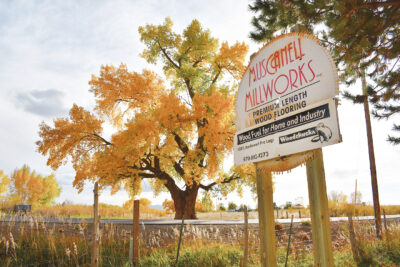With warmer weather conditions here and road bans now ended, supplies to sawmills were reported as improved, thus posting some gains in log inventories. Ground conditions were good for harvesting. Logging crews were able to get to their timber tracts. Rising prices are an incentive for sawmills to process as much lumber and pallet stocks as possible. Some contacts commented that finding staff to meet their needs is a challenge. At the time of this writing, the province was in a third wave of COVID-19, and officials issued lockdown orders as recently as April, and then added an extra two weeks, which made it difficult for the industry to keep moving ahead. Markets, contacts noted, are very good for Hard and Soft Maple and other whitewoods as is usual for this time of year. Export demand, they added, is geared to Red and White Oak, Ash, Cherry and Walnut.
According to published data, U.S. Ash lumber and log exports to Canada declined 16 percent each in the first two months of 2021 versus the same period last year. The decline is due to limited supplies. Shortages, it was noted, were still problematic, while demand was described as good. Prices for green and kiln-dried stocks rose sharply the past several months.
Aspen demand is still strong, with supply gaps still being felt heading into late spring. Green lumber availability was tight, however a balance existed between buyers’ needs and developing supplies. As such, prices were firm. It was hoped more Aspen supplies would be available on the market.
With the labor shortage for some companies, Basswood supplies were not as high as they normally were over the winter months and also the focus was on revenue generating species like Soft and Hard Maple. Green Basswood supplies remained below buyers’ needs, and therefore prices rose. With strong housing and renovation markets on both sides of the border, demand for kiln-dried Basswood is pushing up, with prices for many grades and thicknesses being firm to higher.
Demand from cabinets and trim markets is keeping Birch at the top of the list, and providing outlets of full production runs. It is a challenge to source ample supplies for this and other species, which are fueling price inflation. Prices were raised for all thicknesses of green Birch. Kiln-dried business was reported as strong with markets readily absorbing developing supplies.
As the housing markets are strong, Hard Maple has been in constant demand as well as for Hardwood finished goods. Consumers are also favoring Hard Maple. Demand continues to outpace supply, and there is ongoing price inflation. Kiln-dried Hard Maple orders are outpacing supply.
Soft Maple demand has also remained steady, and supplies are insufficient to meet buyers’ needs, causing rising prices. A slight increase in green Soft Maple availability was noted, as some sawmills focused on whitewood decks before sap stain set in and ahead of warmer weather.
As is the case for this time of year, whitewoods are being processed due to concerns of staining. As a result, Red Oak supplies are down, as the focus is on replenishing Hard and Soft Maple. Domestic and international demand for Red Oak is noted as good, but inventories are thin.
White Oak exports were down, noted contacts, due more to a supply issue than lack of demand. Demand was high, kiln dried inventories thin, and reported prices had risen sharply over time. Green White Oak markets are also strong.
Recently, Finance Minister Chrystia Freeland tabled Budget 2021. It contains $101 billion in new spending over three years to restart the economy. It includes a $12-billion extension of COVID-19 business aid programs and other income supports. Some highlights of this spending includes investments in helping employers recruit and train workers for the skilled trades sector and includes a new service to help connect apprentices with employers. A Recovery Plan for Jobs, Growth and Resilience, proposes $470 million in funding over three years beginning this year to Employment and Social Development Canada (ESDC) to establish a new Apprenticeship Service. The details are still being developed, but it will begin this month and end in November, covering up to 50 percent of the costs associated with staffing up – whether that means recalling previous workers, adding new staff or increasing their hours.
The Budget also proposes $55 million over three years to ESDC for a Community Workforce Development Program aimed to help communities develop local plans identifying high potential growth organizations and connecting employers with training providers to develop and deliver training and work placements to upskill and reskill jobseekers to fill in demand jobs.
$54.8 million over two years, starting in 2021-22, goes to Natural Resources Canada, to enhance the capacity of the Investments in Forest Industry Transformation program including biofuels, bioplastics and building materials. Developing and marketing these new biomaterials will help protect good jobs in hundreds of Canadian communities. Investments are being made to get ahead of worsening fire patterns. Sustainable forest management and Canada’s forestry workers are part of the first line of defence in supporting forest health and keeping communities safer from fire. Budget 2021 investments in wildfire mapping, community resilience, and enhancements to the Canadian Interagency Forest Fire Centre are welcome news.
$67.2 million over seven years, starting in 2021-22, is toward Environment and Climate Change Canada. This standard creates new economic opportunities for Canada’s biofuel producers, including farmers and foresters, who are part of the diverse supply chain for low-carbon fuels.
The continuation of the Canada Emergency Wage Subsidy and the Canada Emergency Rent Subsidy, and the Lockdown Support for businesses and employees affected by COVID to the fall of 2021 have also been approved. There is also $30 billion over five years for a national child care program, with continued funding after that first five-year period; and $17 billion for a green recovery, focusing on conservation and cutting emissions. Also, there is a topping up the Liberals’ 10-year, $40-billion housing strategy with an additional $2.5-billion commitment. Some 60 percent of that will go toward construction of 4,500 new units under the Rapid Housing Initiative, to provide vulnerable Canadians with affordable homes.
The Budget also proposes to provide the Government with the legislative authority to add additional qualifying periods until November 20, 2021, should the economic and public health situation warrant it.








